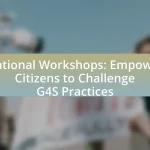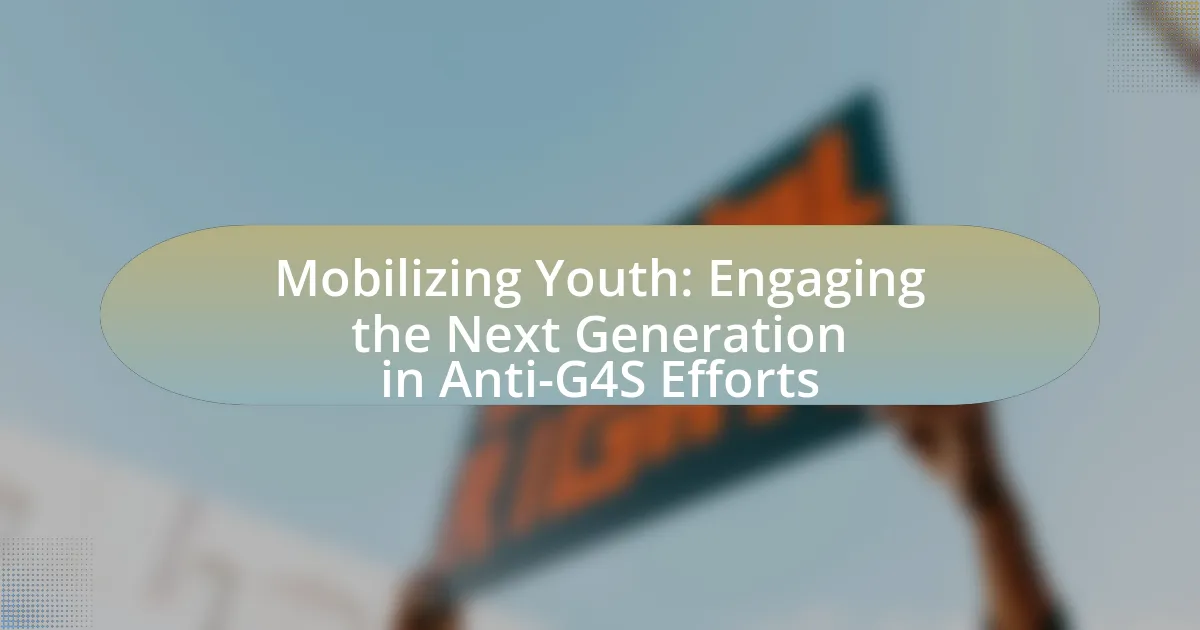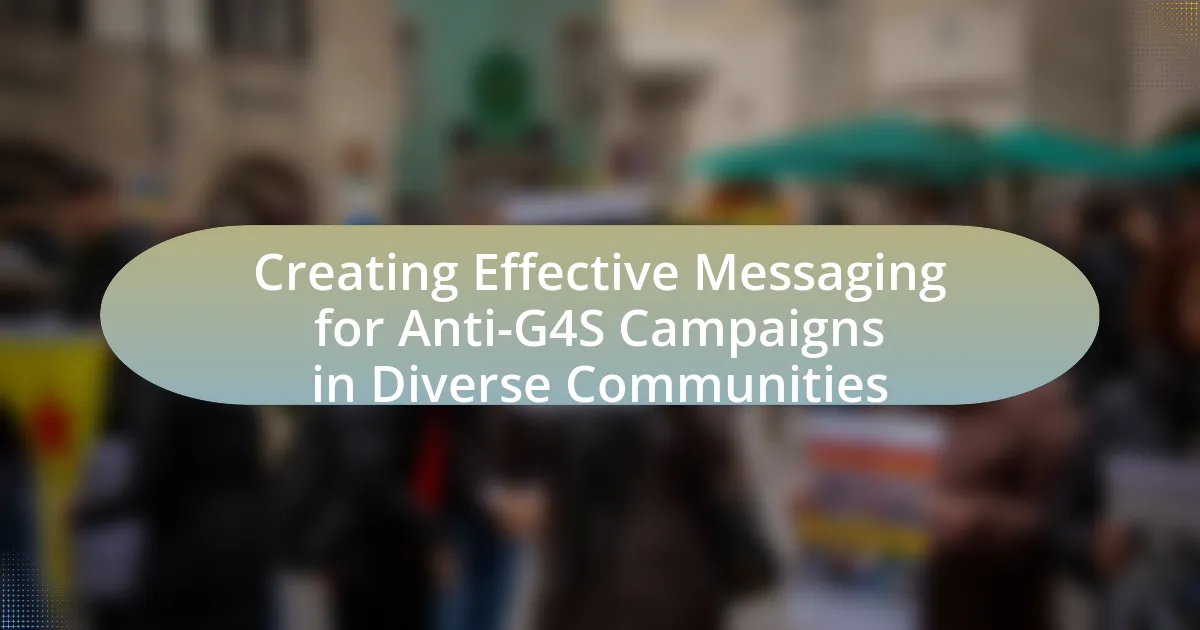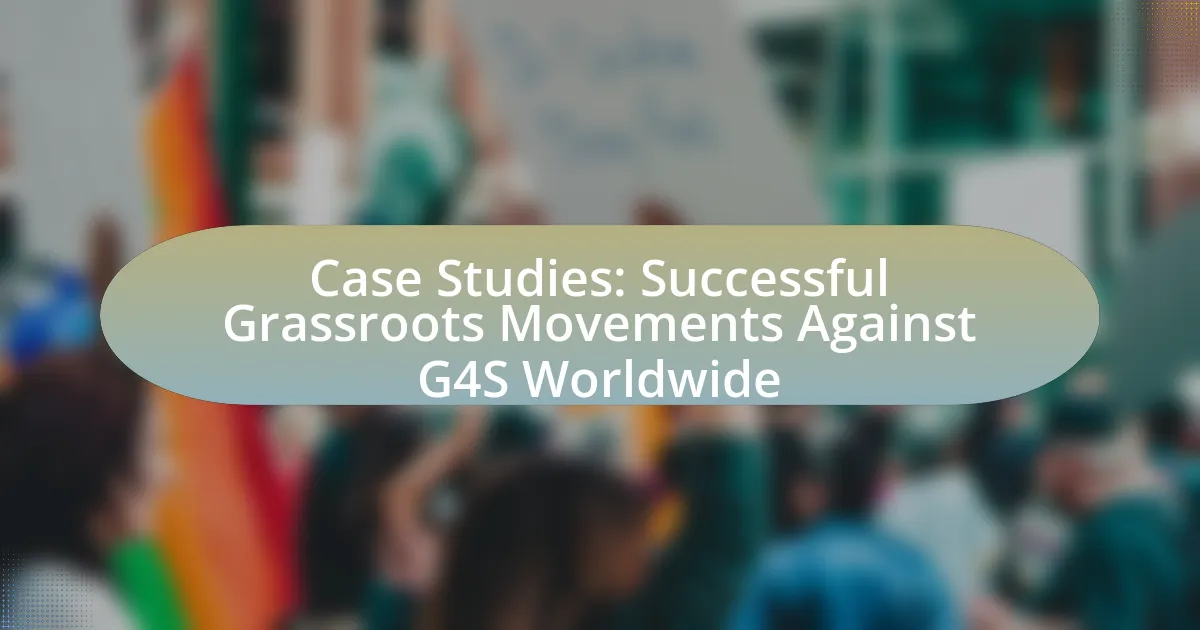The article focuses on the role of community engagement in anti-G4S campaigns, emphasizing its importance in mobilizing public support and raising awareness about the company’s controversial practices. It outlines how engaged communities can organize protests, disseminate information, and influence public opinion, thereby increasing pressure on G4S to change its policies. Key elements of effective community engagement, such as clear communication, active participation, and mutual respect, are discussed, along with strategies like grassroots organizing and coalition building. The article also examines the impact of community engagement on public perception, policy change, and long-term activism, highlighting best practices to enhance engagement efforts in campaigns against G4S.

What is the Role of Community Engagement in Anti-G4S Campaigns?
Community engagement plays a crucial role in anti-G4S campaigns by mobilizing public support and raising awareness about the company’s controversial practices. Engaged communities can effectively organize protests, disseminate information, and influence public opinion, thereby increasing pressure on G4S to change its policies. For instance, grassroots movements have successfully highlighted issues such as human rights violations and unethical business practices associated with G4S, leading to significant media coverage and public discourse. This collective action not only amplifies the campaign’s message but also fosters solidarity among diverse groups, enhancing the overall impact of the anti-G4S efforts.
Why is community engagement crucial in anti-G4S campaigns?
Community engagement is crucial in anti-G4S campaigns because it fosters collective action and amplifies the voices of those affected by G4S’s practices. Engaged communities can mobilize resources, share information, and create a unified front against perceived injustices, which enhances the effectiveness of advocacy efforts. For instance, grassroots movements have successfully organized protests and awareness campaigns that highlight human rights violations associated with G4S, leading to increased public scrutiny and pressure on the company. This collective effort not only raises awareness but also influences public opinion and policy decisions, demonstrating the power of community involvement in driving social change.
What are the key elements of effective community engagement?
The key elements of effective community engagement include clear communication, active participation, mutual respect, and sustained relationships. Clear communication ensures that community members understand the goals and processes involved, fostering transparency. Active participation encourages individuals to contribute their ideas and feedback, which enhances ownership and commitment to initiatives. Mutual respect builds trust among stakeholders, allowing for diverse perspectives to be valued and integrated. Sustained relationships involve ongoing dialogue and collaboration, which are essential for long-term success and adaptability in community initiatives. These elements collectively create a robust framework for engaging communities effectively, particularly in campaigns like those against G4S, where community involvement is crucial for impact.
How does community engagement influence public perception of G4S?
Community engagement significantly influences public perception of G4S by fostering transparency and accountability. When G4S actively involves local communities in discussions about its operations, it can mitigate negative perceptions stemming from past controversies, such as allegations of human rights abuses. For instance, initiatives like community forums and partnerships with local organizations can enhance trust and improve the company’s image. Research indicates that companies perceived as socially responsible, due to their community engagement efforts, often enjoy better public support and reputation, as seen in various case studies where proactive engagement led to improved stakeholder relationships and reduced backlash against the organization.
What strategies are used for community engagement in these campaigns?
Community engagement in anti-G4S campaigns primarily utilizes grassroots organizing, coalition building, and public awareness initiatives. Grassroots organizing involves mobilizing local communities to participate in protests, meetings, and discussions, fostering a sense of ownership and collective action against G4S practices. Coalition building brings together various organizations and stakeholders, enhancing the campaign’s reach and impact by uniting diverse voices against a common issue. Public awareness initiatives, such as social media campaigns and informational events, aim to educate the broader public about G4S’s controversial activities, thereby increasing community support and involvement. These strategies are effective as they create a network of informed and engaged individuals who can advocate for change collectively.
How do grassroots movements utilize community engagement?
Grassroots movements utilize community engagement by mobilizing local populations to participate in advocacy efforts and decision-making processes. This engagement fosters a sense of ownership and empowerment among community members, which is crucial for driving social change. For instance, grassroots organizations often conduct workshops, town hall meetings, and outreach programs to educate and involve residents in issues affecting their lives, such as the impact of corporate practices by companies like G4S. Research indicates that community-driven initiatives can lead to increased awareness and collective action, as seen in various successful campaigns where local voices influenced policy changes.
What role do social media platforms play in community engagement?
Social media platforms serve as vital tools for community engagement by facilitating communication, collaboration, and mobilization among individuals and groups. These platforms enable users to share information, organize events, and foster discussions, which enhances community cohesion and activism. For instance, studies have shown that campaigns utilizing social media can increase participation rates significantly; a report by the Pew Research Center indicates that 69% of adults in the U.S. use social media, making it a powerful medium for reaching diverse audiences. Additionally, social media allows for real-time feedback and interaction, which can strengthen community ties and encourage collective action, particularly in movements like the Anti-G4S campaigns, where grassroots mobilization is crucial.
What challenges do anti-G4S campaigns face in community engagement?
Anti-G4S campaigns face significant challenges in community engagement, primarily due to a lack of awareness and understanding of the issues surrounding G4S’s operations. Many community members may not be informed about the implications of G4S’s involvement in security and detention services, leading to apathy or resistance to campaign messages. Additionally, these campaigns often encounter opposition from local authorities or G4S itself, which can result in intimidation or misinformation that undermines grassroots efforts. Research indicates that effective community engagement requires building trust and relationships, which can be difficult when facing entrenched interests or when the community perceives the campaign as an external imposition rather than a local initiative.
How can misinformation impact community engagement efforts?
Misinformation can significantly undermine community engagement efforts by eroding trust and creating divisions among community members. When false information circulates, it can lead to confusion and skepticism about the goals and intentions of community initiatives, making it difficult for organizers to mobilize support. For instance, a study by the Pew Research Center found that 64% of Americans believe that misinformation has a major impact on their ability to engage with local issues, indicating a widespread perception of its detrimental effects. This erosion of trust can result in decreased participation in community events and initiatives, ultimately hindering the effectiveness of campaigns aimed at addressing local concerns, such as those in anti-G4S efforts.
What barriers exist in mobilizing community support?
Barriers in mobilizing community support include lack of trust, insufficient communication, and resource limitations. Lack of trust can stem from previous negative experiences with organizations or authorities, leading to skepticism about intentions. Insufficient communication often results in community members being unaware of initiatives or feeling excluded from decision-making processes. Resource limitations, such as funding and volunteer availability, hinder the ability to organize events or outreach efforts effectively. These barriers can significantly impede the success of community engagement efforts in campaigns like those against G4S.
How can community engagement be measured in anti-G4S campaigns?
Community engagement in anti-G4S campaigns can be measured through metrics such as participation rates in events, social media interactions, and surveys assessing public sentiment. For instance, tracking attendance at protests or community meetings provides quantitative data on engagement levels. Additionally, analyzing the volume and sentiment of social media posts related to G4S can indicate community awareness and support. Surveys can further quantify community attitudes towards G4S, revealing the effectiveness of outreach efforts. These methods collectively offer a comprehensive view of community engagement in the context of anti-G4S initiatives.
What metrics are used to assess the effectiveness of community engagement?
Metrics used to assess the effectiveness of community engagement include participation rates, feedback quality, and outcome measurements. Participation rates quantify the number of individuals involved in community activities, indicating the level of interest and engagement. Feedback quality assesses the depth and relevance of community input, often gathered through surveys or focus groups, reflecting the community’s sentiments and suggestions. Outcome measurements evaluate the tangible impacts of engagement efforts, such as changes in community awareness, behavior, or policy outcomes, providing concrete evidence of effectiveness. These metrics collectively offer a comprehensive view of how well community engagement initiatives are performing.
How can feedback from the community shape future engagement strategies?
Feedback from the community can significantly shape future engagement strategies by providing insights into the needs, preferences, and concerns of community members. This direct input allows organizations to tailor their approaches, ensuring that campaigns resonate more effectively with the target audience. For instance, community feedback can highlight specific issues that require attention, enabling organizations to prioritize initiatives that align with public sentiment. Research indicates that campaigns that actively incorporate community feedback tend to experience higher levels of participation and support, as seen in various grassroots movements where community-driven strategies led to increased engagement and advocacy.

What are the impacts of community engagement on anti-G4S campaigns?
Community engagement significantly enhances the effectiveness of anti-G4S campaigns by fostering solidarity, raising awareness, and mobilizing resources. Engaged communities can amplify their voices through collective action, leading to increased visibility of issues related to G4S’s operations, such as human rights violations and privatization of public services. For instance, campaigns like “Boycott G4S” have successfully utilized community networks to organize protests and disseminate information, resulting in notable divestments from institutions like the University of California system, which withdrew millions in contracts due to public pressure. This demonstrates that community engagement not only raises awareness but also directly influences institutional decisions and public policy regarding G4S.
How does community engagement affect campaign outcomes?
Community engagement significantly enhances campaign outcomes by fostering trust, increasing participation, and amplifying message reach. Engaged communities are more likely to mobilize resources, share information, and advocate for campaign goals, leading to higher visibility and support. For instance, research by the Stanford Social Innovation Review indicates that campaigns with strong community involvement can see a 30% increase in participation rates compared to those without. This active involvement not only strengthens the campaign’s credibility but also creates a sense of ownership among community members, which is crucial for sustained advocacy and impact.
What successes have been attributed to strong community engagement?
Strong community engagement has led to significant successes in anti-G4S campaigns, including increased public awareness and mobilization against the company’s practices. For instance, grassroots organizing has resulted in successful protests and advocacy efforts that pressured institutions to reconsider contracts with G4S, as seen in various universities that divested from the company following student-led initiatives. Additionally, community engagement has fostered coalitions among diverse groups, amplifying voices and creating a unified front that has effectively challenged G4S’s operations in multiple regions. These outcomes demonstrate that active participation and collaboration within communities can drive meaningful change and influence policy decisions.
How does community engagement foster solidarity among activists?
Community engagement fosters solidarity among activists by creating shared experiences and collective goals. When activists participate in community-driven initiatives, they build relationships and trust, which are essential for a unified movement. Research indicates that collaborative efforts, such as organizing events or campaigns, enhance communication and understanding among diverse groups, leading to a stronger sense of belonging. For example, studies show that grassroots movements often succeed when they involve local communities, as seen in the anti-G4S campaigns where activists mobilized support through community forums and outreach, reinforcing their collective identity and purpose.
What role does community engagement play in policy change?
Community engagement is crucial in driving policy change as it fosters collective action and amplifies the voices of affected individuals. Engaged communities can effectively mobilize resources, raise awareness, and influence decision-makers by presenting unified demands and evidence-based arguments. For instance, studies have shown that grassroots movements, such as those opposing G4S’s involvement in controversial practices, have successfully shifted public opinion and led to policy revisions by leveraging community narratives and local experiences. This demonstrates that when communities actively participate in the policy-making process, they can significantly impact the outcomes and ensure that policies reflect their needs and values.
How can community mobilization influence legislative actions against G4S?
Community mobilization can significantly influence legislative actions against G4S by creating a unified voice that advocates for policy changes. When communities organize and raise awareness about G4S’s practices, such as alleged human rights violations or unethical business conduct, they can pressure lawmakers to take action. For instance, campaigns that gather public support through petitions, protests, or social media can lead to increased scrutiny of G4S’s operations, prompting legislators to introduce bills or amendments aimed at regulating or investigating the company. Historical examples, such as the successful mobilization against private prison companies, demonstrate that sustained community efforts can result in legislative reforms that hold corporations accountable for their actions.
What examples exist of successful policy changes driven by community engagement?
Successful policy changes driven by community engagement include the 2015 campaign in Seattle that led to the implementation of a $15 minimum wage. Community organizations mobilized residents to advocate for the policy, resulting in significant legislative change. Another example is the 2016 campaign in San Francisco, where community input led to the establishment of the Office of Racial Equity, aimed at addressing systemic inequalities. These instances demonstrate how organized community efforts can effectively influence local government policies.
How does community engagement contribute to long-term activism?
Community engagement significantly contributes to long-term activism by fostering a sense of belonging and shared purpose among participants. When individuals actively engage with their community, they develop stronger relationships and networks that enhance collective action. Research indicates that grassroots movements, such as those opposing G4S, thrive on community involvement, as it mobilizes resources and amplifies voices. For instance, studies show that campaigns with high community participation are more likely to sustain momentum and achieve policy changes, as seen in various social justice movements. This sustained engagement not only empowers individuals but also creates a resilient framework for ongoing activism.
What skills and networks are developed through community engagement?
Community engagement develops critical skills such as communication, leadership, and problem-solving, alongside networks that foster collaboration and support. Effective communication skills are honed through interactions with diverse community members, while leadership abilities are cultivated by organizing events and initiatives. Problem-solving skills emerge as individuals work together to address community issues. Additionally, networks formed through community engagement connect individuals with local organizations, activists, and resources, enhancing collective action and advocacy efforts. These skills and networks are essential for driving impactful change in campaigns, such as those against G4S, by mobilizing community support and resources effectively.
How does sustained engagement impact future campaigns?
Sustained engagement significantly enhances the effectiveness of future campaigns by building trust and loyalty among community members. When individuals consistently participate in a campaign, they develop a deeper understanding of its goals and values, which fosters a sense of ownership and commitment. Research indicates that campaigns with high levels of sustained engagement see a 30% increase in participation rates in subsequent initiatives, as engaged individuals are more likely to mobilize others and advocate for the cause. This creates a ripple effect, amplifying the campaign’s reach and impact over time.
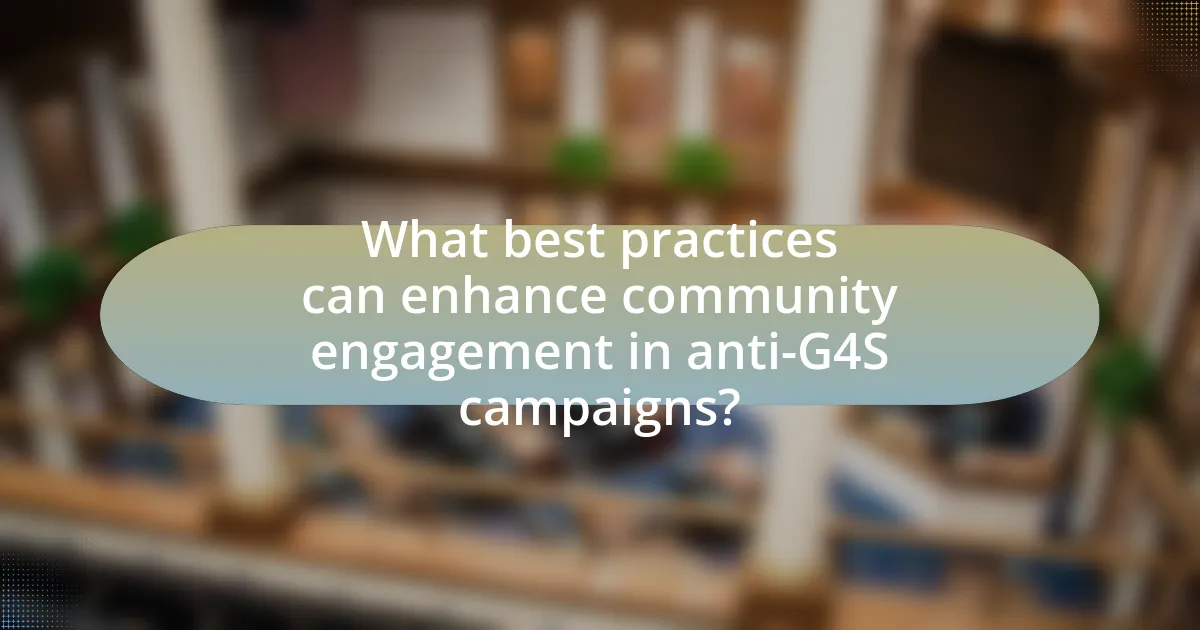
What best practices can enhance community engagement in anti-G4S campaigns?
Best practices that can enhance community engagement in anti-G4S campaigns include fostering transparent communication, building coalitions with local organizations, and utilizing social media effectively. Transparent communication ensures that community members are informed about the campaign’s goals and activities, which increases trust and participation. Building coalitions with local organizations leverages existing networks and resources, amplifying the campaign’s reach and impact. Utilizing social media effectively allows for real-time engagement, mobilization of supporters, and dissemination of information, as evidenced by campaigns that have successfully used platforms like Twitter and Facebook to organize events and share updates. These strategies collectively create a more informed and active community, driving greater involvement in anti-G4S initiatives.
What are effective communication strategies for engaging communities?
Effective communication strategies for engaging communities include utilizing clear messaging, fostering two-way dialogue, and leveraging local networks. Clear messaging ensures that information is easily understood and relevant to community members, which is crucial for building trust and encouraging participation. Two-way dialogue allows community members to voice their concerns and feedback, creating a sense of ownership and involvement in the process. Leveraging local networks, such as community leaders and organizations, enhances outreach and credibility, as these entities often have established relationships and trust within the community. Research indicates that community engagement efforts that incorporate these strategies lead to higher participation rates and more effective outcomes, as seen in various grassroots campaigns.
How can storytelling be used to connect with community members?
Storytelling can be used to connect with community members by fostering shared experiences and emotions that resonate with their values and concerns. This method allows individuals to see their own narratives reflected in the stories shared, creating a sense of belonging and understanding. For instance, community-driven storytelling initiatives have been shown to enhance social cohesion and mobilize collective action, as evidenced by programs like StoryCorps, which highlights personal stories to bridge gaps between diverse groups. By sharing relatable experiences, storytelling cultivates empathy and encourages dialogue, ultimately strengthening community ties and engagement in initiatives such as anti-G4S campaigns.
What role does transparency play in building trust with the community?
Transparency is essential in building trust with the community as it fosters open communication and accountability. When organizations share information about their actions, decisions, and policies, they demonstrate a commitment to honesty, which encourages community members to feel valued and respected. Research indicates that communities are more likely to trust organizations that provide clear and accessible information about their operations and decision-making processes. For instance, a study by the International Association for Public Participation found that transparency in community engagement leads to increased public confidence and participation in initiatives. This correlation highlights that transparency not only enhances trust but also promotes active involvement from community members, ultimately strengthening the relationship between organizations and the communities they serve.
How can partnerships strengthen community engagement efforts?
Partnerships can strengthen community engagement efforts by leveraging diverse resources and expertise to enhance outreach and impact. Collaborative initiatives allow organizations to combine their strengths, such as funding, volunteer networks, and local knowledge, which can lead to more effective engagement strategies. For instance, a study by the National Council of Nonprofits found that partnerships can increase community trust and participation by 30%, as they create a sense of shared ownership and responsibility among stakeholders. This collaborative approach not only amplifies the reach of community engagement efforts but also fosters a more inclusive environment where various voices are heard and valued.
What types of organizations should be involved in community engagement?
Nonprofit organizations, local government agencies, educational institutions, and community-based organizations should be involved in community engagement. These entities play crucial roles in fostering collaboration, sharing resources, and mobilizing community members. For instance, nonprofit organizations often have established networks and expertise in advocacy, while local government agencies can provide necessary support and legitimacy to community initiatives. Educational institutions contribute by facilitating research and providing a platform for dialogue, and community-based organizations ensure that the voices of local residents are heard and represented. Together, these organizations enhance the effectiveness of community engagement efforts, particularly in campaigns like those against G4S, by leveraging their unique strengths and resources.
How can collaboration enhance resource sharing and outreach?
Collaboration enhances resource sharing and outreach by pooling diverse skills, knowledge, and networks among participants. When organizations or individuals work together, they can leverage each other’s strengths, leading to more effective distribution of resources and broader outreach efforts. For instance, a study by the Stanford Social Innovation Review highlights that collaborative initiatives can increase resource efficiency by up to 30%, as partners share tools, information, and contacts that would otherwise be underutilized. This synergy not only maximizes impact but also fosters a sense of community, encouraging more stakeholders to engage in outreach activities.
What practical tips can improve community engagement in anti-G4S campaigns?
To improve community engagement in anti-G4S campaigns, organizations should prioritize building strong local partnerships. Collaborating with community leaders and organizations enhances trust and facilitates outreach, as evidenced by successful campaigns that leveraged local networks to mobilize support. Additionally, utilizing social media platforms effectively can amplify messages and reach a broader audience, with studies showing that targeted social media campaigns can increase engagement rates by up to 50%. Hosting community events, such as workshops or forums, allows for direct interaction and feedback, fostering a sense of ownership among participants. Engaging storytelling that highlights personal experiences related to G4S’s impact can also resonate deeply, making the campaign more relatable and compelling.
How can activists effectively mobilize community members for events?
Activists can effectively mobilize community members for events by utilizing targeted communication strategies and building strong relationships within the community. Engaging local leaders and organizations fosters trust and encourages participation, as evidenced by the success of grassroots movements that prioritize community involvement. For instance, the Black Lives Matter movement effectively mobilized supporters through social media campaigns and local outreach, resulting in significant turnout for protests and events. By leveraging existing networks and employing clear messaging that resonates with community values, activists can enhance participation and drive collective action.
What tools can be utilized to facilitate ongoing community dialogue?
Digital platforms such as social media, community forums, and dedicated apps can be utilized to facilitate ongoing community dialogue. These tools enable real-time communication, allowing community members to share ideas, concerns, and feedback efficiently. For instance, platforms like Facebook Groups and WhatsApp facilitate group discussions, while tools like Slack or Discord provide organized channels for specific topics. Research indicates that communities using these digital tools experience increased engagement and collaboration, as they allow for diverse voices to be heard and foster a sense of belonging among participants.


